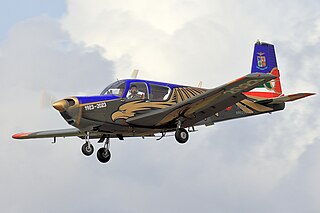
The Schempp-Hirth Nimbus 3 is a glider built by Schempp-Hirth.

The Glaser-Dirks DG-400 is a single-seat self-launching motorglider that was produced by Glaser-Dirks between 1981 and 1992. It was the first self-launching motorglider with retractable engine and propeller to be produced in large numbers.
The Valmet L-80 TP Turbo-Vinha was a prototype for a new Finnish turboprop basic trainer aircraft. The aircraft, which carried the registration OH-VBB, first flew on 12 February 1985. It was destroyed in a crash on 24 April 1985, during its 14th flight, killing the test pilot Paavo Janhunen. The aircraft was a further development of the Valmet L-70 Vinka and would eventually lead to the Valmet L-90 Redigo.

ENAER T-35 Pillán is a Chilean propeller-driven basic trainer aircraft. The student and the instructor sit in tandem. Production ceased in 1991 after 7 years but restarted briefly in 1998.

The SIAI-Marchetti S.205 is an Italian four-seat, single-engine, light airplane, manufactured by SIAI-Marchetti. The S.205 made its maiden flight in 1965. The Italian Air Force employs a version called S.208.

The Caproni Vizzola C22 Ventura was a light jet-powered aircraft developed in Italy for use as a military trainer. It was of conventional sailplane configuration and bore a family resemblance to the Caproni Calif gliders, although the Ventura had an almost entirely metal structure. The student and instructor sat side by side under an expansive canopy, and weapons hardpoints were provided under each of the slender, high-mounted wings. It had retractable, tricycle undercarriage.

The Piaggio P.150 was a 1950s Italian two-seat trainer designed and built by Piaggio to meet an Italian Air Force requirement to replace the North American T-6.

The VSO 10 Vosa is a Standard and Club-Class glider designed and manufactured in the Czechoslovak Republic from December 1978 as a replacement for the VT-116 Orlik II.

The Italair F.20 Pegaso was a twin-engine utility aircraft designed by Stelio Frati and built in Italy in 1971.

The IAR-824 was a utility aircraft built in Romania in the 1970s.
The ICA IS-32 is an open class high-performance metal two-seat sailplane produced in Romania in the 1970s. A refinement of the IS-28B, it shared most of that aircraft's fuselage, mated to new wings and empennage. This new wing had a span of 20 metres, featuring interconnected ailerons and flaps, Schempp-Hirth-type airbrakes. It had no provision for water ballast. The monowheel undercarriage differed from the IS-28 in being fully retractable.

The Lederlin 380L is an unconventional light aircraft developed in France in the 1960s, and marketed for homebuilding.
The PIK-3 was a sailplane produced in Finland in the 1950s and 60s. It was designed to be a cheap and easy-to-build aircraft to equip the country's gliding clubs as their standard single-seat machine. It was a conventional design for its day, with a high wing and conventional empennage. Construction was of wood throughout, skinned in plywood.

The PIK-5 was a training glider produced in Finland in the 1940s, and 1950s, equipping the country's gliding clubs with an aircraft greater in performance than primary gliders but less than competition sailplanes.

The PIK-15 Hinu is a light aircraft developed in Finland in the 1960s for use as a glider tug. It was a low-wing cantilever monoplane of conventional design with an enclosed cockpit and fixed, tailwheel undercarriage. The cockpit had two seats, side-by-side, and the PIK-15 was intended to have a secondary role as a trainer. Construction was of wood throughout.

The PIK-19 Muhinu was a light aircraft developed in Finland in the early 1970s for use as a glider tug and flight trainer. It was a low-wing cantilever monoplane of conventional configuration, with an enclosed cockpit and fixed, tricycle undercarriage. Its construction was of composite materials throughout, a novel approach at the time. When the PIK-19 flew for the first time in 1972, it was only the fourth aircraft in the world made of these materials.

The LAK-12 is a Lithuanian mid-wing, single-seat, FAI Open Class glider that was designed and produced by Lietuviškos Aviacinės Konstrukcijos (LAK) in Lithuania and later by Sportine Aviacija and Sport Aviation USSR.
The Aeroandina MXP-1000 Tayrona is a single engine, high wing, two seat ultralight, based on the Zenair formula, developed in Colombia by AeroAndina. It was launched in 2005.

The Heinonen HK-1 Keltiäinen is a Finnish single-seat, single-engined sport aircraft of the 1950s. Three examples were built. The first was used by its designer to set a class distance record in 1957 that stood for 18 years before being beaten.
The Grob G 110 was a single-engined two-seat light aircraft, made mainly of glassfibre, that was designed and built by the German manufacturer Grob Aircraft in the early 1980s. Two prototypes were built, with the first example making its maiden flight on 6 February 1982, but development was abandoned after the first prototype crashed later that year.















